- Waste management in Japan
- Circular economy in Japan
- Waste management in Asia
- Disaster waste management
Waste Stream in the Republic of the Marshall Islands
Introduction
The Republic of the Marshall Islands requested technical assistance from Japan with the aim of advancing appropriate waste management and promoting recycling. In response to this request, I was dispatched as a JICA senior volunteer to the Majuro Atoll Waste Company (MAWC), a Majuro-based public corporation. I worked with MAWC's local staff for about two years on a waste management program.
This article will introduce what waste items are generated on this small island and how they are disposed of.
The Republic of the Marshall Islands
The Republic of the Marshall Islands, located in Micronesia to the southeast of Japan, is a low-lying atoll country with a maritime tropical climate, consisting of scattered 29 atolls and 1,225 islands. Among them is Bikini Atoll, well known as a site for hydrogen bomb testing. The atolls are situated between latitudes 4° N and 19° N, and longitudes 160° E and 175° E. The country has a large exclusive economic zone of 2 million km2, compared to its small land area of 181 km2 equivalent to the area of Lake Kasumigaura in Ibaraki Prefecture, Japan. The major industries in the Marshalls are agriculture (coconut), fisheries, coconut oil production and seafood processing. The country is heavily dependent on imports of living necessities such as everyday items and food supplies.
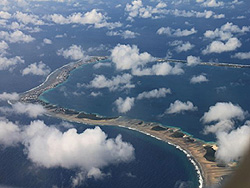
Waste management on Majuro Atoll
The capital Majuro Atoll is in the southeast of the Marshall Islands. It has an area of 9.8 km2 and a population of 27,700 (as of 2009), or about 45% of the national population.
On Majuro Atoll, except for some areas, household waste is collected once a week on a regular basis after it is separated into three types: landfill waste, green waste (fallen leaves from palm and banana trees and pruning waste) and bulky waste. Business related waste from specific contract holders such as hotels and shops is collected on an irregular basis. The remaining portion of the business waste is directly carried to the disposal sites. Altogether, a total of about 20 tons of waste is generated and disposed of on Majuro Atoll every day. With the population of the waste collection area, the amount of waste generated per person per day is estimated to be 0.90 kg. As shown in Table 1, household waste accounts for 35% of the total waste generated. Business waste accounts for 65%. Majuro generates more waste compared to other Pacific island countries.
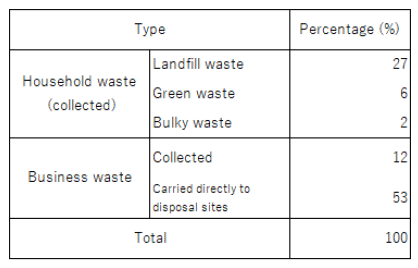
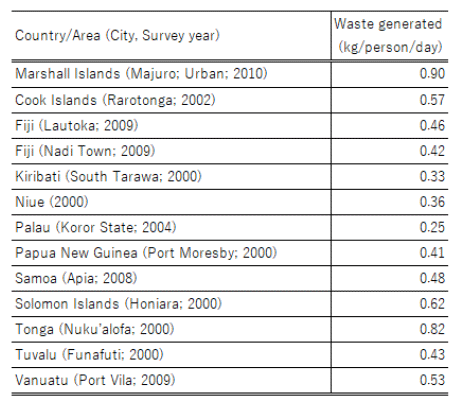
Characteristics of household waste composition
The Majuro Atoll Waste Company (MAWC) is responsible for the disposal of waste generated on Majuro Atoll. In addition to household/business waste collection, green waste composting, landfill waste disposal, and collection/recycling/export of aluminum cans from landfill waste, MAWC has been actively promoting waste reduction, recycling and outreach activities in cooperation with the Environmental Protection Agency.
When promoting waste reduction and recycling, it is very important to know what items are disposed of as waste. With these thoughts, I conducted a household waste survey from April to August 2010 to analyze composition of the landfill waste (27% of the total amount) which MAWC collected from five districts. The waste was categorized into 20 items (see Table 3) in line with MAWC's waste treatment. After the analysis of the waste from each district, the weight percentage of each item was calculated using simple average method. The survey revealed the following results.
Out of the landfill waste analyzed, "grass/wood" accounts for the largest percentage at 28.8% including "compostable waste" (22.9%). When combined with the percentage of separately collected "green waste," the ratio of all the grass and wood waste becomes even higher. This is one of the characteristics of the waste in tropical countries where evergreen palm and breadfruit trees defoliate all year around. A large amount of fallen leaves from these trees are disposed of as waste. The item "disposable diapers" represents the second largest percentage followed by "plastics" and "paper." In the "plastics" category, "plastic bags" and "plastic container/packaging" both have high percentages. Especially, plastic containers/packaging pose a serious problem to the Marshall Islands which disposes of waste mainly through offshore landfill (landfilling in the shallows segmented by concrete blocks). Meanwhile, styrofoam cups and plates have also caused a problem due to their large volume although their weight percentage is small. In order to reduce the volume, a new law to control plastic bags, styrofoam cups/plates, and plastic beverage bottles is expected to be enacted. In the "paper" category, "paperboard (cardboard)" makes up the major portion. This is because the Marshall Islands is dependent on imported food and everyday items as mentioned earlier, and cardboard is used for their delivery. Another reason is that the amount of paper brought into households is limited since no advertising leaflet is delivered with the two major weekly newspapers nor by postal mail. In the "metal" category, "steel cans" have the highest percentage. While most of the collected aluminum cans are the ones for beer and soft drinks, most of the steel cans are food cans. There have been strong efforts to collect aluminum cans, aluminum building materials, and radiators from air conditioners and refrigerators because selling them can still generate profits even after considering transportation (container freight) costs. However, there is no active collection effort for other metals since their sale prices fluctuate considerably.
For the promotion of waste recycling, a small island country needs to fulfill many requirements. It is not an easy task. Moreover, proper disposal of bulky waste, household electric appliances and vehicles poses a bigger challenge.
Lastly, I would like to present a chart comparing the results from the Waste Composition Survey in Majuro with those obtained in Japan. When comparing the waste in the two countries, try to imagine South Pacific islanders' lifestyles.
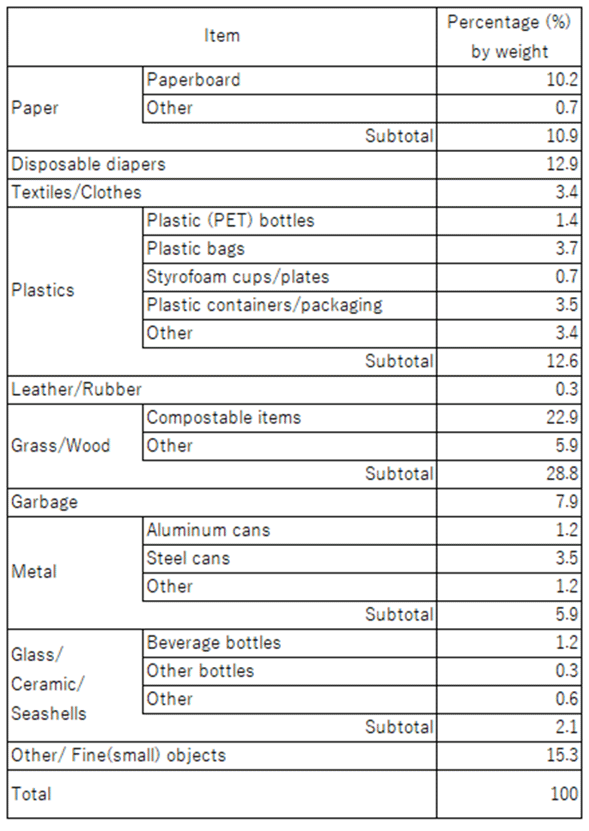
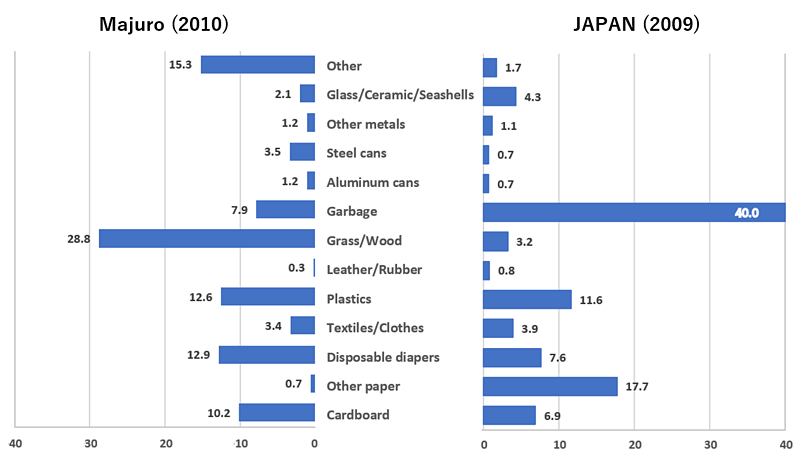
References
- The Secretariat of the Pacific Regional Environment Programme (SPREP) (2010) Pacific Regional Solid Waste Management Strategy 2010-2015, 8* (external link)*Except the Marshall Islands.
- Ministry of the Environment, Japan (2009) Results of the Municipal Waste Composition Survey (in Japanese, external link)


